How Does Density Impact Carbon Emission Intensity: Insights from the Block Scale and an Optimal Parameters-Based Geographical Detector
Abstract
1. Introduction
2. Materials and Methods
2.1. Study Area and Data Sources
2.2. Quantification of Variables
2.2.1. Quantification of the CICL
2.2.2. Description and Quantification of Density System
2.3. Optimal-Parameters-Based Geographical Detector (OPGD)
3. Results
3.1. Discretization Results of Density Factor
3.2. Analysis of Driving Forces of CIRB
3.3. Analysis of Driving Forces of the CICB
3.4. Analysis of Driving Forces of the CIPB
4. Discussion
4.1. Analysis of Single-Factor Driving Forces on CICL
4.2. Analysis of Factor Interaction Driving Forces on the CICL
4.3. Policy Implications
4.4. Limitations and Future Outlook
5. Conclusions
Supplementary Materials
Author Contributions
Funding
Data Availability Statement
Acknowledgments
Conflicts of Interest
References
- Creutzig, F.; Baiocchi, G.; Bierkandt, R.; Pichler, P.P.; Seto, K.C. Global typology of urban energy use and potentials for an urbanization mitigation wedge. Proc. Natl. Acad. Sci. USA 2015, 112, 6283–6288. [Google Scholar] [CrossRef]
- Intergovernmental Panel on Climate Change. Climate Change 2014 Mitigation of Climate Change; Cambridge University Press: Cambridge, UK, 2015; p. 147. [Google Scholar]
- Parry, I.W.H.; Williams, R.C.; Goulder, L.H. When Can Carbon Abatement Policies Increase Welfare? The Fundamental Role of Distorted Factor Markets. J. Environ. Econ. Manag. 1999, 37, 52–84. [Google Scholar] [CrossRef]
- Jin, T.; Yang, J.; Wang, D. From Urban Density Zoning to Form-based Zoning: Evolution and Demonstration. Urban Plan. Forum 2018, 4, 34–40. [Google Scholar]
- Zou, B. From Physical Expansion to Built-up Area Improvement: Shenzhen Master Plan Transition Forces and Paths. Planners 2013, 29, 5–10. [Google Scholar]
- Ge, C.; Zhang, Y.; Li, H.; Guo, Z.; Cai, Y.; Zhao, C.; Liu, X. A New Path toward Governance Transition in Territorial Spatial Planning: The Case of Ningbo. Urban. Plan Forum. 2022, S2, 241–246. [Google Scholar] [CrossRef]
- Krehl, A.; Siedentop, S.; Taubenböck, H.; Wurm, M. A Comprehensive View on Urban Spatial Structure: Urban Density Patterns of German City Regions. ISPRS Int. J. Geo-Inf. 2016, 5, 76. [Google Scholar] [CrossRef]
- Yang, J.; Shi, Y. The Evolution and Prospect of Density Research in the Context of Urban Planning. Urban. Plan. Int. 2023, 38, 1–7. [Google Scholar] [CrossRef]
- Churchman, A. Disentangling the Concept of Density. J. Plan. Lit. 1999, 13, 389–411. [Google Scholar] [CrossRef]
- Berghauser, P.; Haupt, P.M. Spacemate: The Spatial Logic of Urban Density; DUP Science: Dares Salaam, Tanzania, 2004. [Google Scholar]
- Dongsheng, H.; Jia, M.; Yi, L.; Yimeng, S.; Long, C.; Ye, L. Urban greenery mitigates the negative effect of urban density on older adults’ life satisfaction: Evidence from Shanghai, China. Cities 2022, 124, 103607. [Google Scholar]
- Hui, S.C.M. Low energy building design in high density urban cities. Renew. Energy 2001, 24, 627–640. [Google Scholar] [CrossRef]
- Alvarez Palau, E.; Solanas, J. Urban Growth and Long-Term Transformations in Spanish Cities Since the Mid-Nineteenth Century: A Methodology to Determine Changes in Urban Density. Sustainability 2019, 11, 6948. [Google Scholar] [CrossRef]
- Zhang, X.; Yan, F.; Liu, H.; Qiao, Z. Towards low carbon cities: A machine learning method for predicting urban blocks carbon emissions (UBCE) based on built environment factors (BEF) in Changxing City, China. Sustain. Cities Soc. 2021, 69, 102875. [Google Scholar] [CrossRef]
- Dong, Q.; Huang, Z.; Zhou, X.; Guo, Y.; Scheuer, B.; Liu, Y. How building and street morphology affect CO2 emissions: Evidence from a spatially varying relationship analysis in Beijing. Build. Environ. 2023, 236, 110258. [Google Scholar] [CrossRef]
- Ye, H.; He, X.Y.; Song, Y.; Li, X.; Zhang, G.; Lin, T.; Xiao, L. A sustainable urban form: The challenges of compactness from the viewpoint of energy consumption and carbon emission. Energy Build. 2015, 93, 90–98. [Google Scholar] [CrossRef]
- Qin, H.; Huang, Q.; Zhang, Z.; Lu, Y.; Li, M.; Xu, L.; Chen, Z. Carbon dioxide emission driving factors analysis and policy implications of Chinese cities: Combining geographically weighted regression with two-step cluster. Sci. Total Environ. 2019, 684, 413–424. [Google Scholar] [CrossRef]
- Ma, M.; Rozema, J.; Gianoli, A.; Zhang, W. The Impacts of City Size and Density on CO2 Emissions: Evidence from the Yangtze River Delta Urban Agglomeration. Appl. Spat. Anal. Policy 2022, 15, 529–555. [Google Scholar] [CrossRef]
- Tian, D.; Yang, S.; Guan, C.; Li, Y. Correlation between Urban Spatial Agglomeration and Residents’ Household Carbon Emissions: An Analysis Based on the Data of 110 Chinese Cities. City Plan. Rev. 2023, 47, 76–85. [Google Scholar]
- Al-Mulali, U. Factors affecting CO2 emission in the Middle East: A panel data analysis. Energy 2012, 44, 564–569. [Google Scholar] [CrossRef]
- Li, Z.; Wu, H.; Wu, F. Impacts of urban forms and socioeconomic factors on CO2 emissions: A spatial econometric analysis. J. Clean. Prod. 2022, 372, 133722. [Google Scholar] [CrossRef]
- Zhang, Q.; Yang, J.; Sun, Z.; Wu, F. Analyzing the impact factors of energy-related CO2 emissions in China: What can spatial panel regressions tell us? J. Clean. Prod. 2017, 161, 1085–1093. [Google Scholar] [CrossRef]
- Liddle, B. Urban density and climate change: A STIRPAT analysis using city-level data. J. Transp. Geogr. 2013, 28, 22–29. [Google Scholar] [CrossRef]
- Gudipudi, R.; Fluschnik, T.; Ros, A.G.C.; Walther, C.; Kropp, J.P. City density and CO2 efficiency. Energy Policy 2016, 91, 352–361. [Google Scholar] [CrossRef]
- Chen, F.; Shen, S.; Li, Y.; Xu, H. Impact of urban density on spatial carbon performance: A case study of Shanghai. Urban. Probl. 2022, 96–103. [Google Scholar] [CrossRef]
- Resch, E.; Bohne, R.A.; Kvamsdal, T.; Lohne, J. Impact of Urban Density and Building Height on Energy Use in Cities. Energy Procedia 2016, 96, 800–814. [Google Scholar] [CrossRef]
- Quan, S.J.; Economou, A.; Grasl, T.; Yang, P.P. Computing Energy Performance of Building Density, Shape and Typology in Urban Context. Energy Procedia 2014, 61, 1602–1605. [Google Scholar] [CrossRef]
- Wang, W.; Li, J. Correlation between Residential Density and Carbon Emissions Caused by Household Energy Consumption: A Case Study on Caoyang Xincun, Shanghai. City Plan. Rev. 2017, 41, 83–91. [Google Scholar]
- Xu, L.; Du, H.; Zhang, X. Driving Forces of Carbon Dioxide Emissions in China’s Cities: An Empirical Analysis Based on the Geodetector Method. J. Clean. Prod. 2020, 287, 125169. [Google Scholar] [CrossRef]
- Jiang, X.T.; Wang, Q.; Li, R. Investigating factors affecting carbon emission in China and the USA: A perspective of stratified heterogeneity. J. Clean. Prod. 2018, 199, 85–92. [Google Scholar] [CrossRef]
- Long, Z.; Zhang, Z.; Liang, S.; Chen, X.; Yang, T. Spatially explicit carbon emissions at the county scale. Resour. Conserv. Recycl. 2021, 173, 105706. [Google Scholar] [CrossRef]
- Zhao Min, T.X. The Economical Principles of Urban Development and Urban Planning; Higher Education Press: Beijing, China, 2001. [Google Scholar]
- Hongtao, J.; Jian, Y.; Bin, Z.; Danqi, W.; Xinyuan, L.; Yi, D.; Ruici, X. Industrial Carbon Emission Distribution and Regional Joint Emission Reduction: A Case Study of Cities in the Pearl River Basin, China. Chin. Geogr. Sci. 2024, 34, 210–229. [Google Scholar]
- Shahrokni, H.; Levihn, F.; Brandt, N. Big meter data analysis of the energy efficiency potential in Stockholm’s building stock. Energy Buildings 2014, 78, 153–164. [Google Scholar] [CrossRef]
- Dean, B.; Dulac, J.; Petrichenko, K.; Graham, P. Towards Zero-Emission Efficient and Resilient Buildings: Global Status Report; Global Alliance for Buildings and Construction (GABC): Paris, France, 2016. [Google Scholar]
- Houghton, J.T. Revised 1996 IPCC Guidelines for National Greenhouse Gas Inventories; IPCC Task Force on National Greenhouse Gas Inventories: Geneva, Switzerland, 1996. [Google Scholar]
- Cao, Q.; Luan, Q.; Liu, Y.; Wang, R. The effects of 2D and 3D building morphology on urban environments: A multi-scale analysis in the Beijing metropolitan region. Build. Environ. 2021, 192, 107635. [Google Scholar] [CrossRef]
- Wu, W.; Li, L.; Li, C. Seasonal variation in the effects of urban environmental factors on land surface temperature in a winter city. J. Clean. Prod. 2021, 299, 126897. [Google Scholar] [CrossRef]
- Uytenhaak, R. Cities Full of Space: Quality of Density; Nai010 Publishers: Rotterdam, The Netherlands, 2009. [Google Scholar]
- Nes, A.V.; Pont, M.B.; Mashhoodi, B. Combination of Space syntax with spacematrix and the mixed use index: The Rotterdam South test case. In Proceedings of the 8th International Space Syntax Symposium, Santiago, Chile, 3–6 January 2012. [Google Scholar]
- Zhang, P.; Hu, Y.; Xiong, Z. Extraction of Three-Dimensional Architectural Data from QuickBird Images. J. Indian Soc. Remote 2014, 42, 409–416. [Google Scholar] [CrossRef]
- Jiang, L.; Liu, S.; Liu, L.; Liu, C. Revealing the spatiotemporal characteristics and drivers of the block-scale thermal environment near a large river: Evidences from Shanghai, China. Build. Environ. 2022, 226, 109728. [Google Scholar] [CrossRef]
- Lu, C.; Pang, M.; Zhang, Y.; Li, H.; Cheng, W. Mapping Urban Spatial Structure Based on POI (Point of Interest) Data: A Case Study of the Central City of Lanzhou, China. Int. J. Geo-Inf. 2020, 9, 92. [Google Scholar] [CrossRef]
- Chen, C.; Bi, L. Study on spatio-temporal changes and driving factors of carbon emissions at the building operation stage- A case study of China. Build. Environ. 2022, 219, 109147. [Google Scholar] [CrossRef]
- Yang, J.; Song, C.; Yang, Y.; Xu, C.; Guo, F.; Xie, L. New method for landslide susceptibility mapping supported by spatial logistic regression and GeoDetector: A case study of Duwen Highway Basin, Sichuan Province, China. Geomorphology 2018, 324, 62–71. [Google Scholar] [CrossRef]
- Luo, L.; Mei, K.; Qu, L.; Zhang, C.; Chen, H.; Wang, S.; Di, D.; Huang, H.; Wang, Z.; Xia, F. Assessment of the Geographical Detector Method for investigating heavy metal source apportionment in an urban watershed of Eastern China. Sci. Total Environ. 2019, 653, 714. [Google Scholar] [CrossRef]
- Wang, J.-F.; Zhang, T.-L.; Fu, B.-J. A measure of spatial stratified heterogeneity. Ecol. Indic. Integr. Monit. Assess. Manag. 2016, 67, 250–256. [Google Scholar] [CrossRef]
- Shrestha, A.; Luo, W. Analysis of Groundwater Nitrate Contamination in the Central Valley: Comparison of the Geodetector Method, Principal Component Analysis and Geographically Weighted Regression. ISPRS Int. J. Geo-Inf. 2017, 6, 297. [Google Scholar] [CrossRef]
- Zhang, R.; Chen, Y.; Zhang, X.; Fang, X.; Ma, Q.; Ren, L. Spatial-Temporal Pattern and Driving Factors of Flash Flood Disasters in Jiangxi Province Analyzed by Optimal Parameters-Based Geographical Detector. Geogr. Geo-Inf. Sci. 2021, 37, 72–80. [Google Scholar]
- Chen, G.; Luo, J.; Zhang, C.; Jiang, L.; Tian, L.; Chen, G. Characteristics and Influencing Factors of Spatial Differentiation of Urban Black and Odorous Waters in China. Sustainability 2018, 10, 4747. [Google Scholar] [CrossRef]
- Wang, J.; Xu, C. Geodetector: Principle and prospective. Acta Geogr. Sin. 2017, 72, 116–134. [Google Scholar]
- Wu, D.; Lin, J.C.; Oda, T.; Kort, E.A. Space-based quantification of per capita CO2 emissions from cities. Environ. Res. Lett. 2020, 15, 035004. [Google Scholar] [CrossRef]
- Rosenfeld, H. Mitigation of Urban Heat Islands: Material, Utility Programs, Updates. Enegy Build. 1995, 22, 255–265. [Google Scholar] [CrossRef]
- Anderson, J.E.; Wulfhorst, G.; Lang, W. Energy analysis of the built environment—A review and outlook. Renew. Sustain. Energy Rev. 2015, 44, 149–158. [Google Scholar] [CrossRef]
- Wei, W.; Yan, S.; Zaisheng, H.; Yihua, L. Research of the Influence of Community Form on residential Energy Consumption: A Case Study on Ningbo City. Urban Dev. Stud. 2018, 25, 15–20. [Google Scholar]
- Rode, P.; Keim, C.; Robazza, G.; Viejo, P.; Schofield, J. Cities and energy: Urban morphology and residential heat-energy demand. Environ. Plan. B: Plan. Des. 2014, 41, 138–162. [Google Scholar] [CrossRef]
- Wilson, B. Urban form and residential electricity consumption: Evidence from Illinois, USA. Landsc. Urban Plan. 2013, 115, 62–71. [Google Scholar] [CrossRef]
- Krizek, K.J. Residential Relocation and Changes in Urban Travel. J. Am. Plan. Assoc. 2003, 69, 265–281. [Google Scholar] [CrossRef]
- Peijun, R.; Lijun, Z.; Yaochen, Q.; Yang, L.I.; Zhicheng, Z. Impact of built environment on carbon emissions from daily travel of urban residents: A case study of 248 residential areas in Kaifeng. Geogr. Res.-Aust. 2019, 38, 1464–1480. [Google Scholar]
- Jiyu, D. Research on Urban Spatial Form of Cbd Based on Microclimate Analysis—A Case Study of Nanjing. Ph.D. Thesis, Southeast University, Nanjing, China, 2019. [Google Scholar]
- Zheng, Y.; Du, S.; Zhang, X.; Bai, L.; Wang, H. Estimating carbon emissions in urban functional zones using multi-source data: A case study in Beijing. Build. Environ. 2022, 212, 108804. [Google Scholar] [CrossRef]
- Olivier, J.G.J.; Van Aardenne, J.A.; Dentener, F.J.; Pagliari, V.; Ganzeveld, L.N.; Peters, J.A.H.W. Recent trends in global greenhouse gas emissions: Regional trends 1970–2000 and spatial distribution of key sources in 2000. Environ. Sci. 2005, 2, 81–99. [Google Scholar] [CrossRef]
- Yoshida, T.; Yamagata, Y.; Murakami, D. Energy demand estimation using quasi-real-time people activity data. Energy Procedia 2019, 158, 4172–4177. [Google Scholar] [CrossRef]
- Chuai, X.; Feng, J. High resolution carbon emissions simulation and spatial heterogeneity analysis based on big data in Nanjing City, China. Sci. Total Environ. 2019, 686, 828–837. [Google Scholar] [CrossRef]
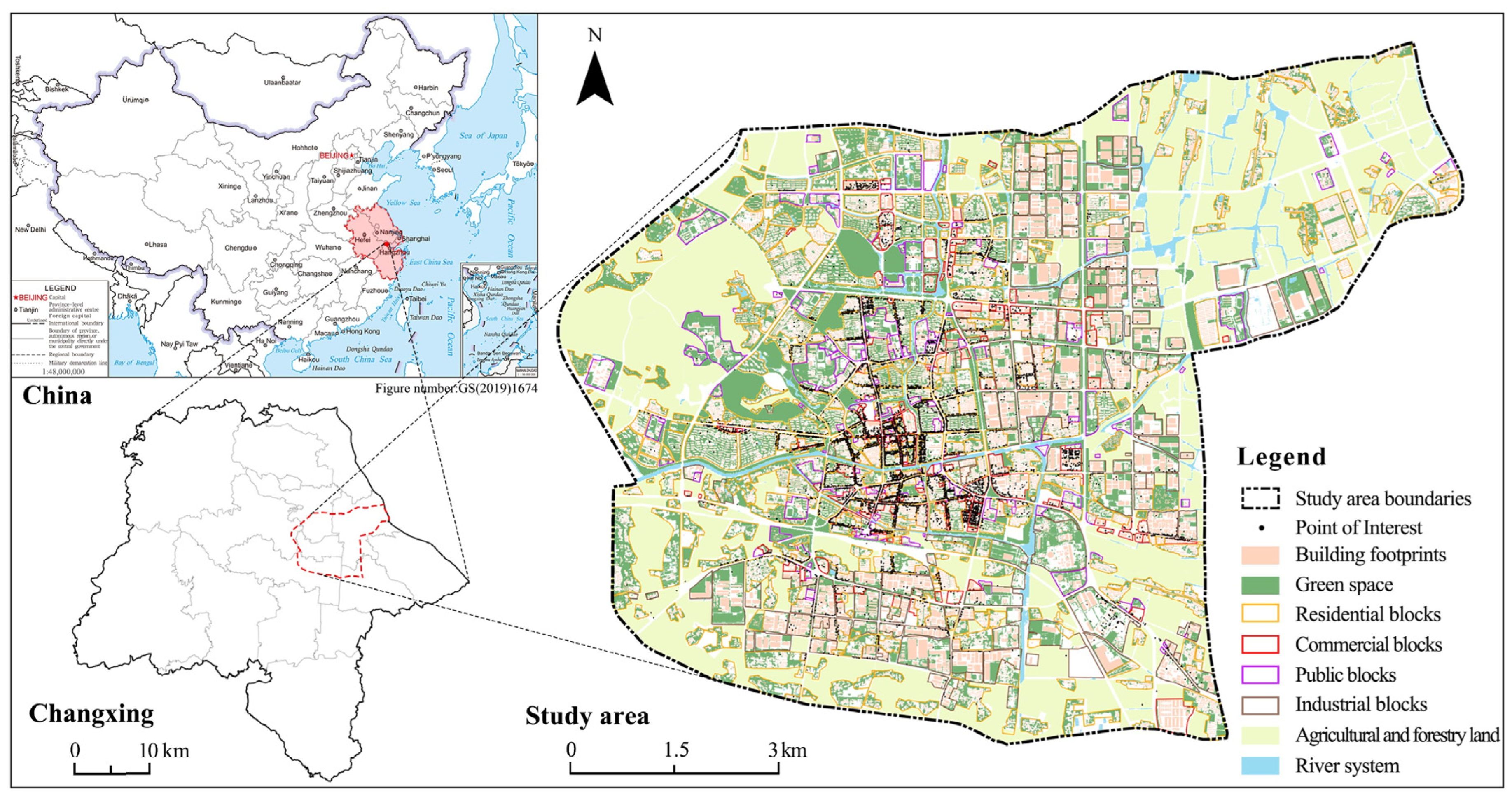
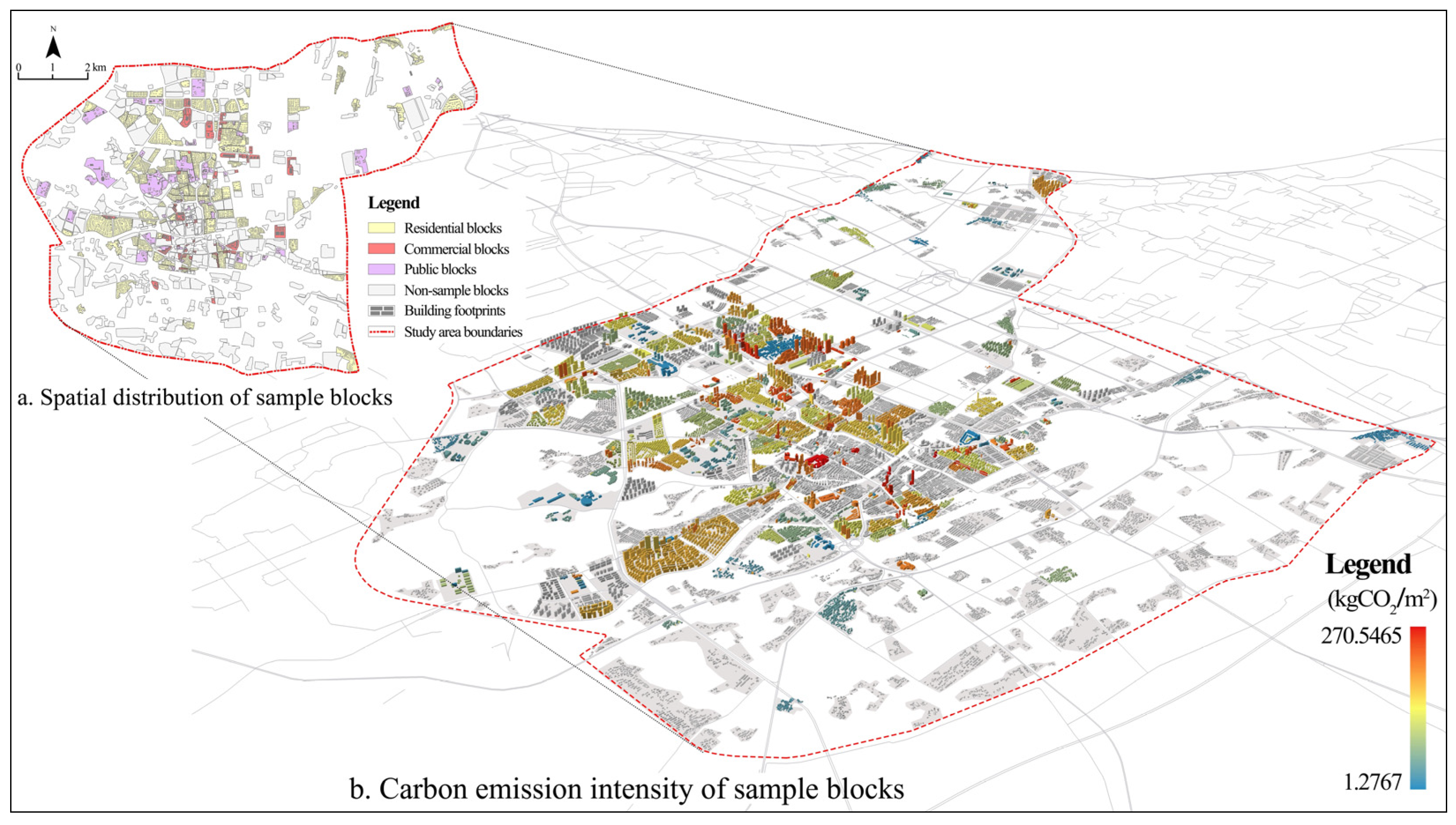
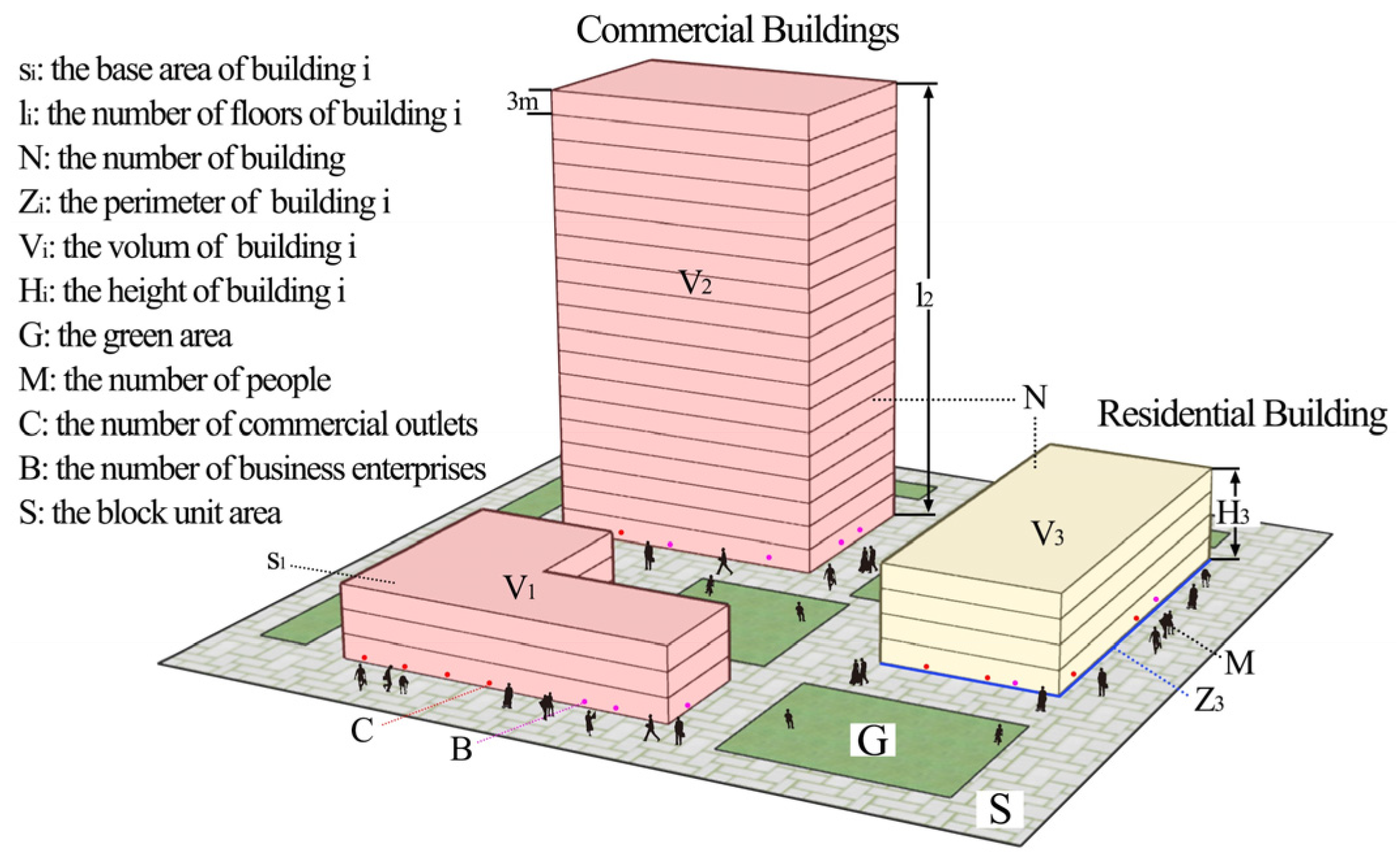
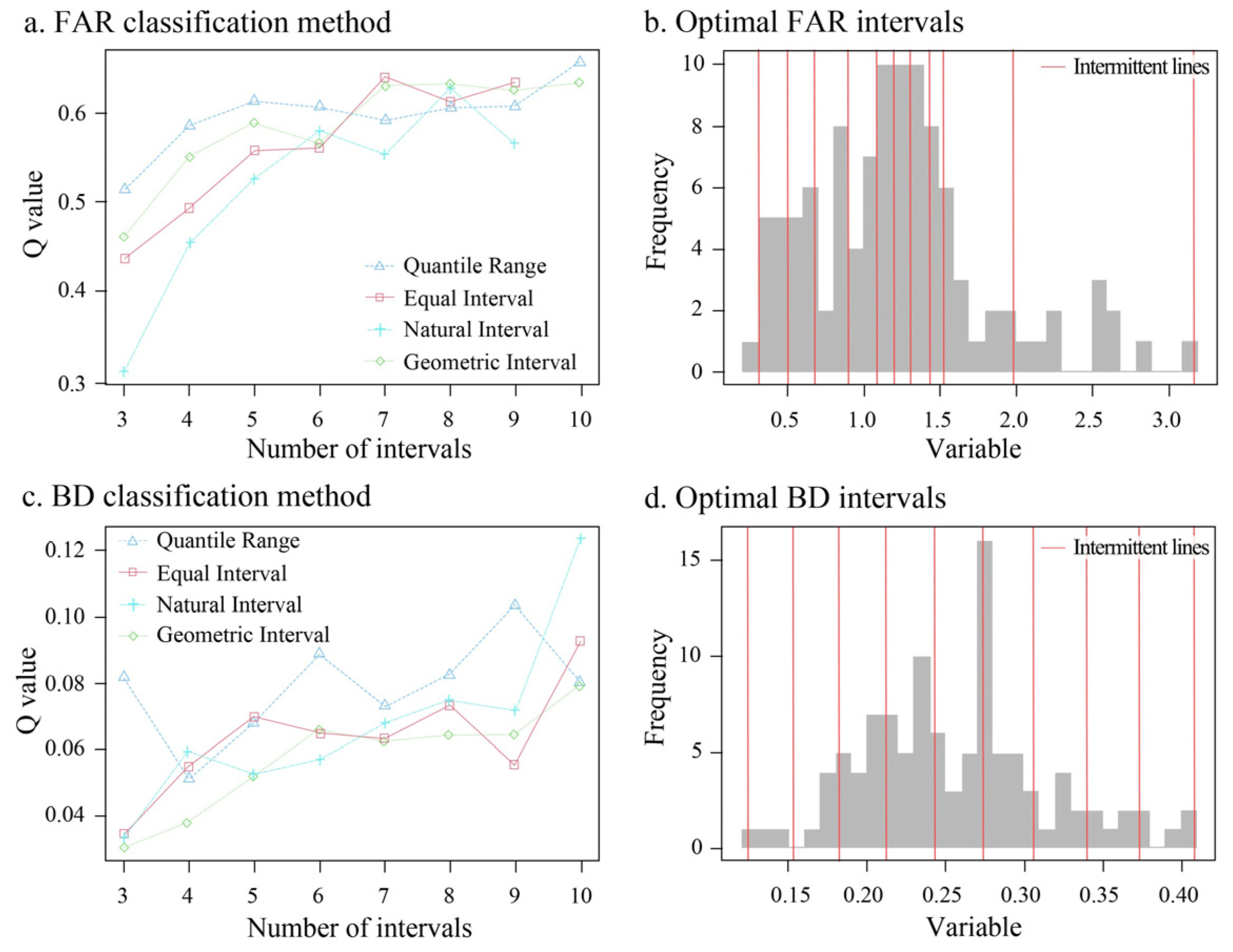
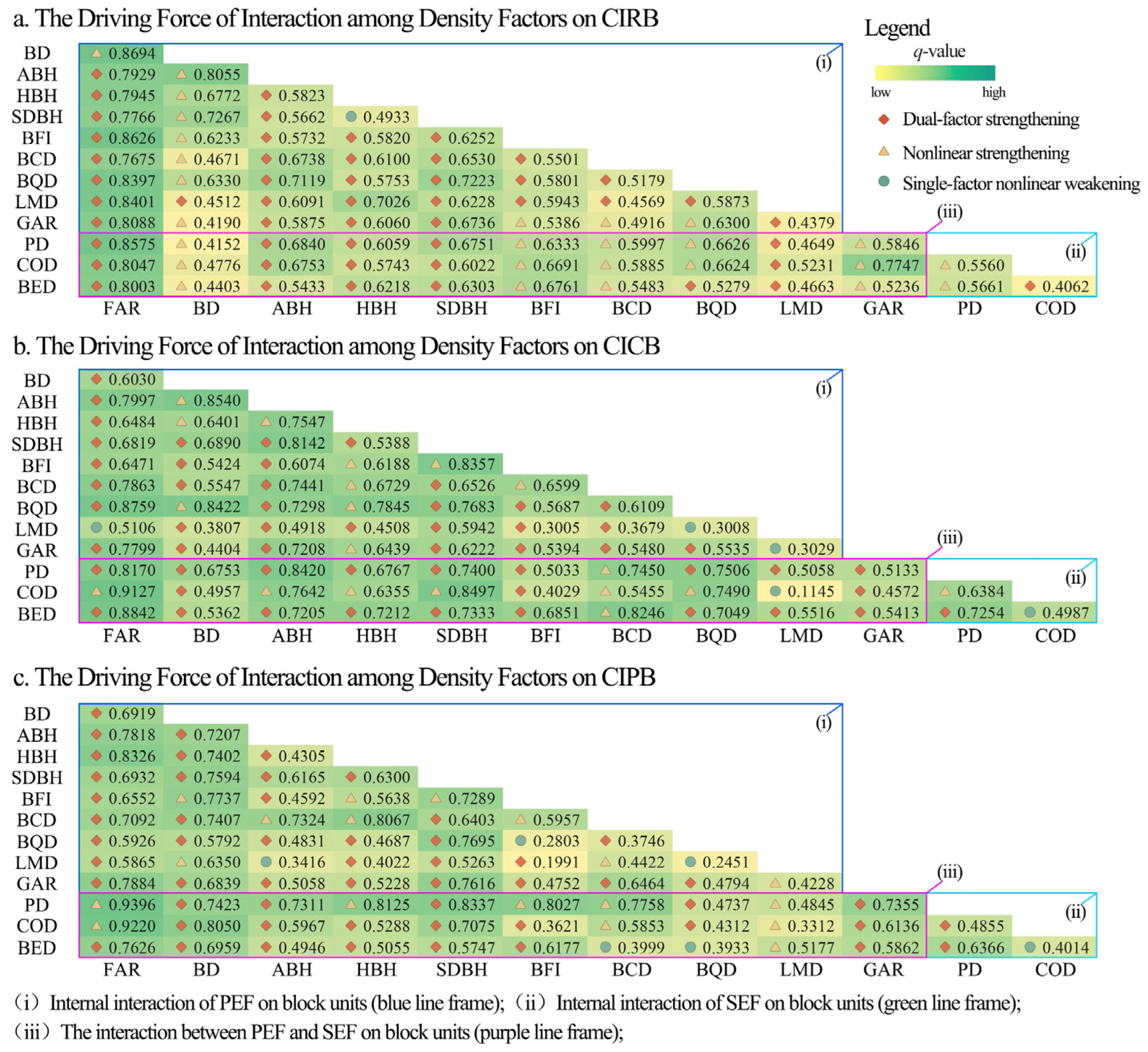
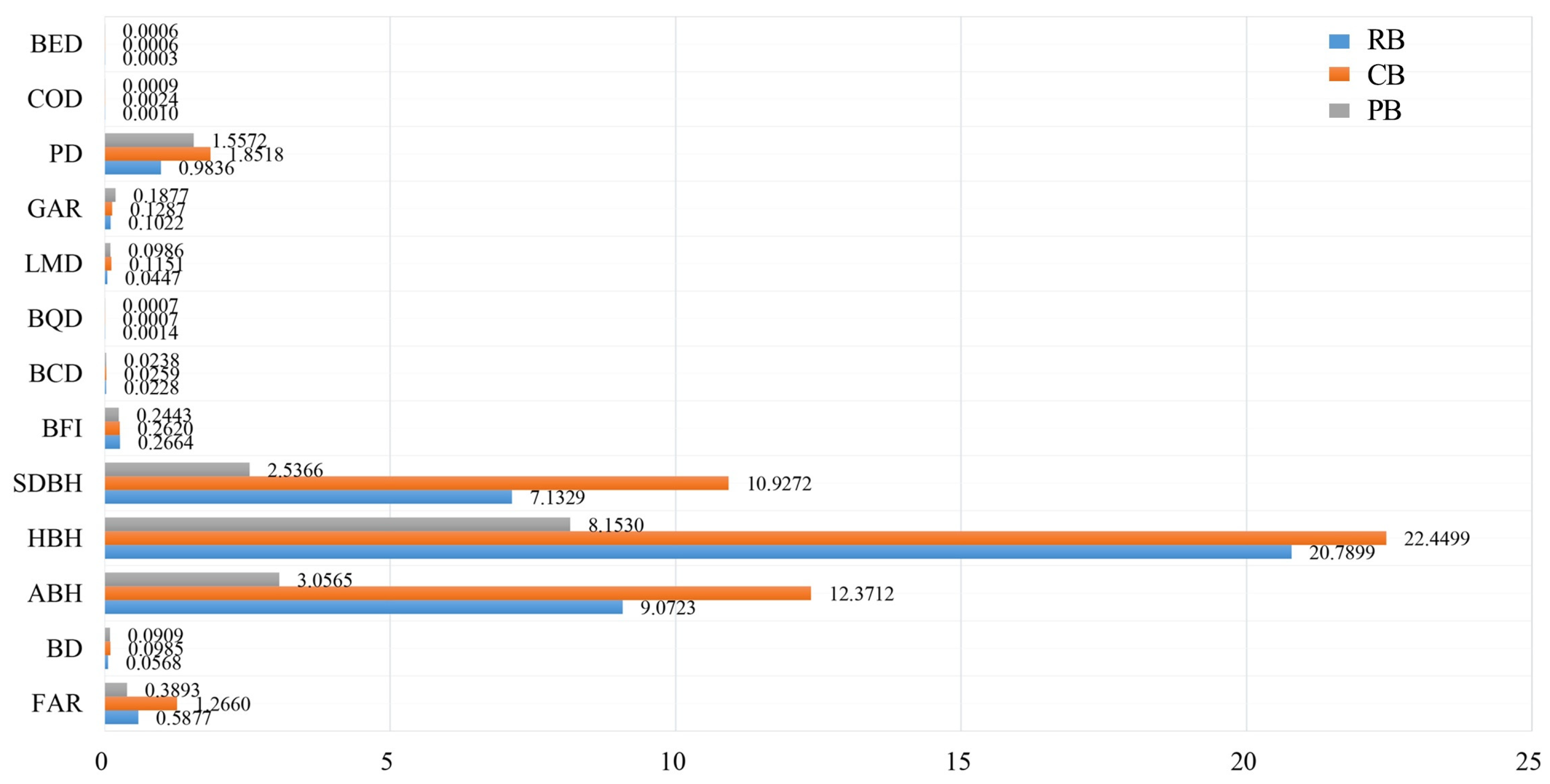
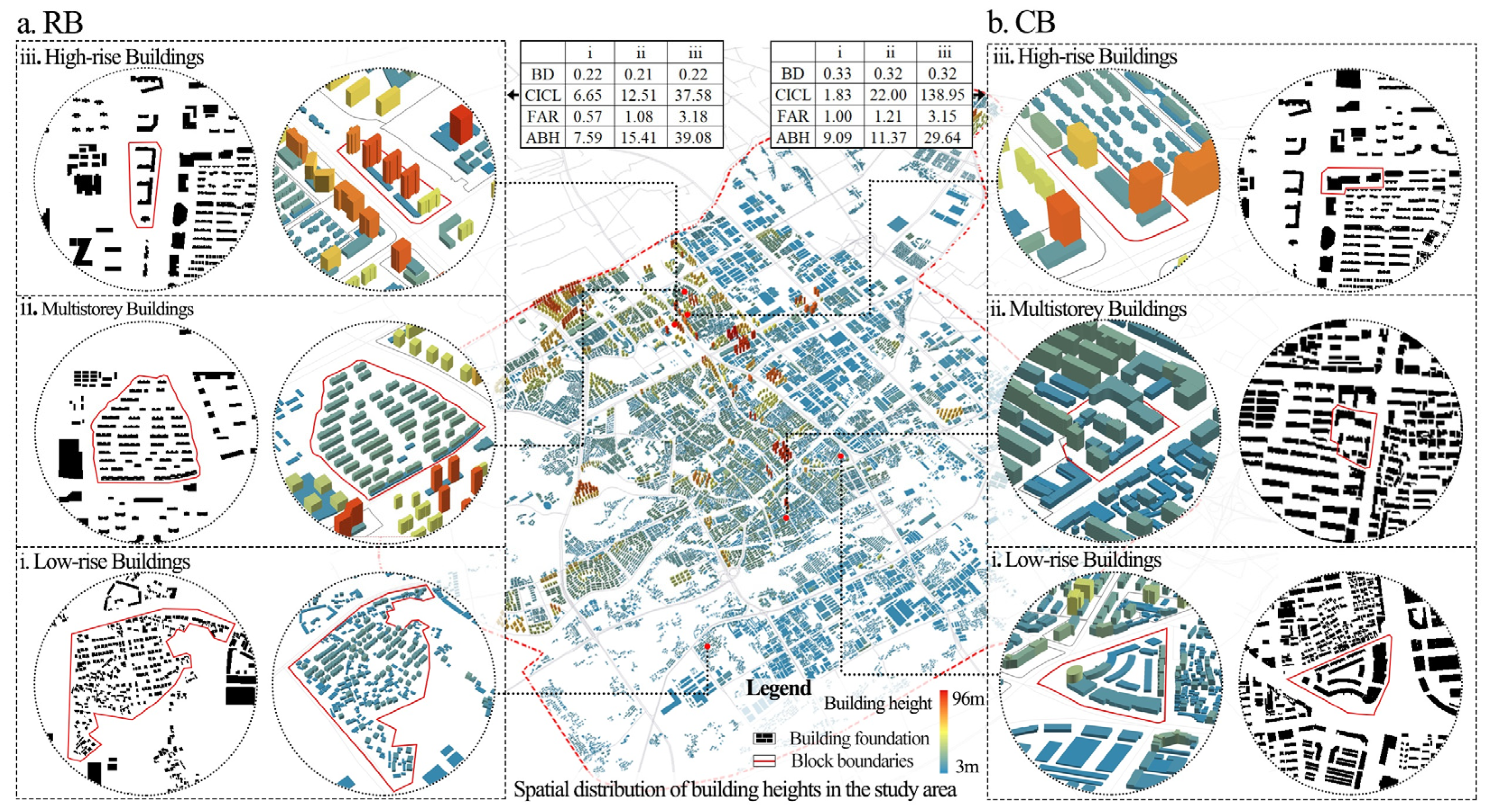
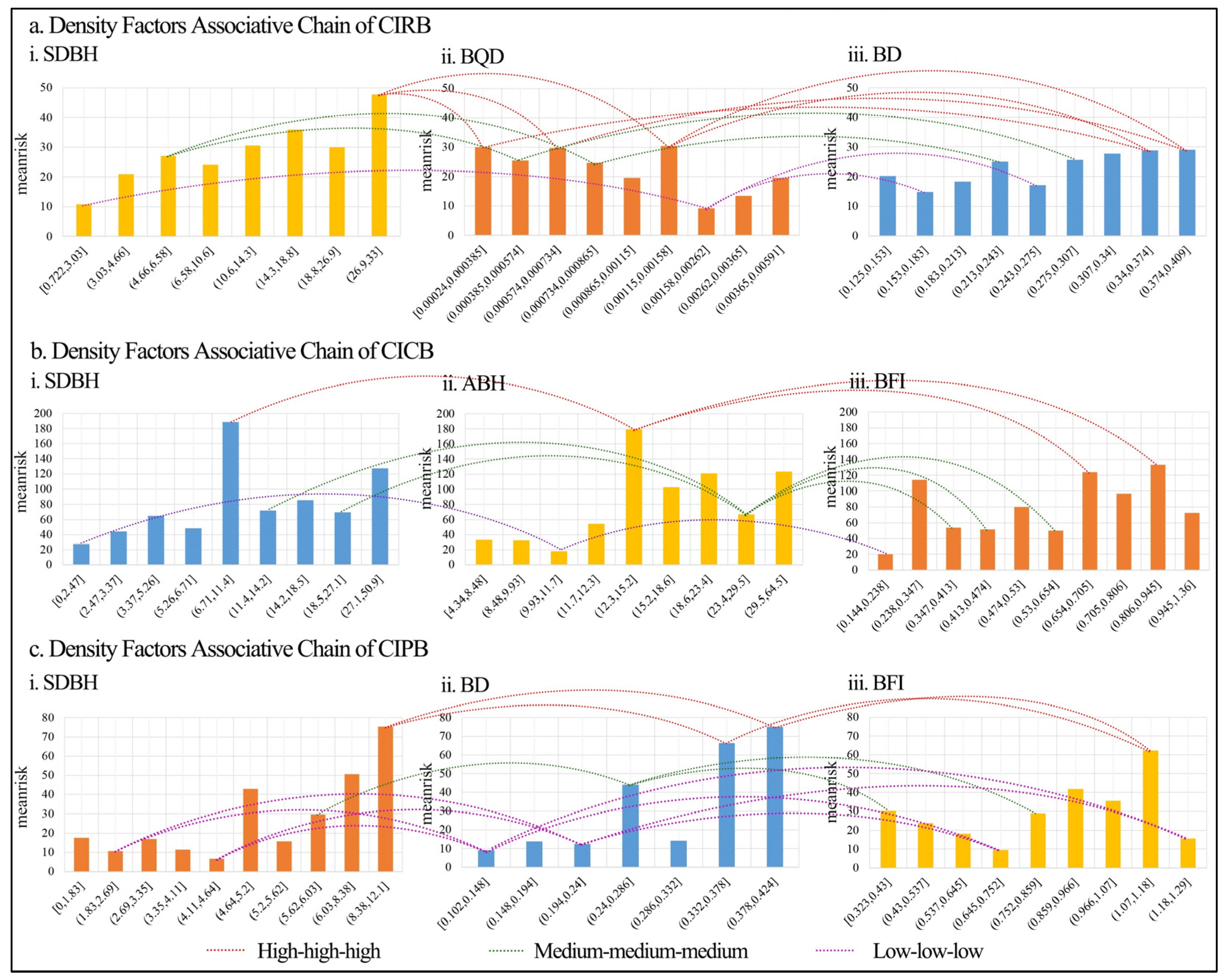
| Density System | Equation | Indicator Description | |
|---|---|---|---|
| Physical Environmental Factors (PEFs) | Floor area ratio (FAR) | Reflecting the block development intensity. | |
| Building density (BD) | Reflecting the proportion of the block covered by buildings. | ||
| Average building height (ABH) | Reflecting the average height of buildings on the block. | ||
| Highest building height (HBH) | Reflecting the maximum building height on the block. | ||
| Standard deviation of building height (SDBH) | Reflecting the dispersion and variation in building heights on the block. | ||
| Building facade indicators (BFIs) | Reflecting the conditions of natural light, landscape, spatial perception, etc., for buildings on the block. | ||
| Building congestion degree (BCD) | Reflecting the proportion of building volumes on the block. | ||
| Land use mix density (LMD) | Reflecting the degree of mixed block use functionality. | ||
| Building quantity density (BQD) | Reflecting the quantitative characteristics of buildings on the block. | ||
| Green area ratio (GAR) | Reflecting the level of green areas on the block. | ||
| Socioeconomic Factors (SEFs) | Population density (PD) | Reflecting the characteristics of the population distribution on the block. | |
| Commercial outlet density (COD) | Reflecting the characteristics of the commercial outlet distribution on the block. | ||
| Business enterprise density (BED) | Reflecting the characteristics of the distribution of business companies on the block. | ||
| Variable | RB | CB | PB | |||||||||
|---|---|---|---|---|---|---|---|---|---|---|---|---|
| MEAN | SD | Min | Max | MEAN | SD | Min | Max | MEAN | SD | Min | Max | |
| CICL | 22.522 | 12.079 | 1.711 | 59.635 | 80.190 | 71.790 | 1.277 | 270.547 | 27.843 | 30.089 | 2.135 | 120.176 |
| FAR | 1.227 | 0.588 | 0.299 | 2.855 | 2.063 | 1.266 | 0.639 | 6.735 | 0.798 | 0.389 | 0.254 | 1.882 |
| BD | 0.256 | 0.057 | 0.125 | 0.409 | 0.359 | 0.099 | 0.164 | 0.558 | 0.222 | 0.091 | 0.102 | 0.424 |
| ABH | 15.289 | 9.072 | 4.665 | 41.726 | 18.196 | 12.371 | 4.344 | 64.458 | 10.772 | 3.057 | 4.479 | 20.056 |
| HBH | 29.208 | 20.790 | 9.000 | 96.000 | 34.714 | 22.450 | 9.000 | 84.000 | 18.167 | 8.153 | 9.000 | 54.000 |
| SDBH | 7.692 | 7.133 | 0.722 | 33.020 | 12.410 | 10.927 | 0.000 | 50.912 | 4.798 | 2.537 | 0.000 | 12.096 |
| BFI | 1.010 | 0.266 | 0.497 | 1.608 | 0.573 | 0.262 | 0.144 | 1.358 | 0.767 | 0.244 | 0.323 | 1.288 |
| BCD | 0.051 | 0.023 | 0.013 | 0.106 | 0.040 | 0.026 | 0.006 | 0.112 | 0.037 | 0.024 | 0.006 | 0.130 |
| BQD | 0.002 | 0.001 | 0.000 | 0.006 | 0.001 | 0.001 | 0.000 | 0.003 | 0.001 | 0.001 | 0.000 | 0.003 |
| LMD | 0.031 | 0.045 | 0.000 | 0.204 | 0.057 | 0.115 | 0.000 | 0.445 | 0.041 | 0.099 | 0.000 | 0.423 |
| GAR | 0.321 | 0.102 | 0.104 | 0.638 | 0.122 | 0.129 | 0.000 | 0.551 | 0.255 | 0.188 | 0.000 | 0.694 |
| PD | 0.251 | 0.984 | 0.000 | 8.902 | 0.992 | 1.852 | 0.000 | 8.716 | 0.860 | 1.557 | 0.002 | 8.580 |
| COD | 0.001 | 0.001 | 0.000 | 0.006 | 0.002 | 0.002 | 0.000 | 0.010 | 0.000 | 0.001 | 0.000 | 0.005 |
| BED | 0.000 | 0.000 | 0.000 | 0.002 | 0.001 | 0.001 | 0.000 | 0.002 | 0.000 | 0.001 | 0.000 | 0.004 |
| Density System | a. CIRB | b. CICB | c. CIPB | |
|---|---|---|---|---|
| PEFs | FAR | 0.7086 ** | 0.5378 ** | 0.5652 ** |
| BD | / | / | 0.5433 ** | |
| ABH | 0.4849 ** | 0.4902 ** | 0.3609 ** | |
| HBH | 0.5003 ** | / | 0.3871 * | |
| SDBH | 0.5265 ** | 0.4088 * | 0.5062 ** | |
| BFI | 0.3537 ** | / | / | |
| BCD | 0.2133 * | / | / | |
| BQD | 0.3428 ** | 0.3715 * | 0.2932 * | |
| LMD | 0.3463 * | / | / | |
| GR | / | / | 0.3780 ** | |
| SEFs | PD | 0.2345 ** | 0.4204 * | 0.3732 * |
| COD | 0.3143 ** | / | / | |
| BED | 0.2770 * | 0.4993 * | 0.4541 * | |
Disclaimer/Publisher’s Note: The statements, opinions and data contained in all publications are solely those of the individual author(s) and contributor(s) and not of MDPI and/or the editor(s). MDPI and/or the editor(s) disclaim responsibility for any injury to people or property resulting from any ideas, methods, instructions or products referred to in the content. |
© 2024 by the authors. Licensee MDPI, Basel, Switzerland. This article is an open access article distributed under the terms and conditions of the Creative Commons Attribution (CC BY) license (https://creativecommons.org/licenses/by/4.0/).
Share and Cite
Li, L.; Yan, F. How Does Density Impact Carbon Emission Intensity: Insights from the Block Scale and an Optimal Parameters-Based Geographical Detector. Land 2024, 13, 1036. https://doi.org/10.3390/land13071036
Li L, Yan F. How Does Density Impact Carbon Emission Intensity: Insights from the Block Scale and an Optimal Parameters-Based Geographical Detector. Land. 2024; 13(7):1036. https://doi.org/10.3390/land13071036
Chicago/Turabian StyleLi, Liutong, and Fengying Yan. 2024. "How Does Density Impact Carbon Emission Intensity: Insights from the Block Scale and an Optimal Parameters-Based Geographical Detector" Land 13, no. 7: 1036. https://doi.org/10.3390/land13071036
APA StyleLi, L., & Yan, F. (2024). How Does Density Impact Carbon Emission Intensity: Insights from the Block Scale and an Optimal Parameters-Based Geographical Detector. Land, 13(7), 1036. https://doi.org/10.3390/land13071036






